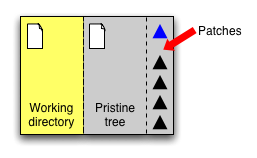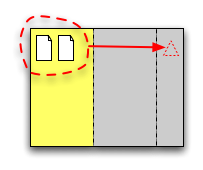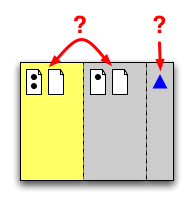Understanding Darcs/Getting started
Anatomy of a darcs repository[edit | edit source]
Understanding how to use the darcs commands can be a lot easier if you have a rough idea how things work. We're not asking you to learn about patch commutation algebra (yet), but one thing you should at least be comfortable with is the anatomy of a darcs repository.

The idea of the diagram is as follows: the stuff on the left in yellow is you. That's what darcs calls the working directory. The stuff in grey, on the other hand, is part of that mysterious _darcs directory if you've played around with darcs before. This can be broken down some more. The pristine tree (middle) is exactly like your working directory, except only representing the last saved state. It's not essential to darcs's operations, but it makes things run more efficiently, and is perhaps useful for understanding how things work. Finally, the right-most portion is the set of patches. Patches are what makes darcs... well... darcs. Darcs thinks in patches. Almost every darcs operation somehow involves (darcs) juggling some patches around behind the scenes. Enthusiastic darcs users find that this makes life easier in a number of ways. For example, accepting patches to your code becomes an extremely natural thing to do - you just let darcs apply them and in they go. But before we get to that, let's tackle a small set of essential commands.
Essential commands[edit | edit source]
init[edit | edit source]
Say you have a directory with some files in it. When you run darcs init to initialise the repository, you get an empty new darcs repository. Your working directory might contain files, but darcs does not know about them yet.

add[edit | edit source]
darcs add tells darcs to keep track of a file or directory that was only in your working directory. It creates or adds to a special temporary patch which we call the pending patch (will be represented in blue). Note that it does not affect your pristine tree whatsover! The idea is that we haven't saved your work (which is what the pristine tree is for). We've only told darcs that we might conceivably want to save it later on.

Note that the pending patch is different from all the other patches. It is really a representation of (some) things you have not yet converted into a real darcs patch.
whatsnew[edit | edit source]
The darcs whatsnew compares the working directory against the pristine tree (theoretically, against the set of patches) and displays what has changed between them. If there is anything in the pending patch, it also displays the contents of that.

record[edit | edit source]
The darcs record command is how you save your work. It copies your chosen changes from the working directory to the pristine tree, and more importantly, creates a new patch representing those changes. Changes can also come from the pending patch, and these changes will also be propagated into the pristine tree.
